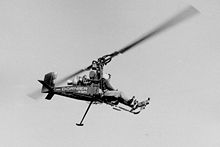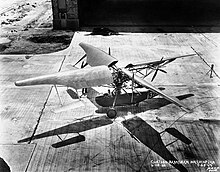Blade tip drive
The blade tip drive is a design for helicopters in which the main rotor is driven by a force acting tangentially on the tip of each rotor blade. Since the drive force is not transmitted via a shaft (rotor shaft ), there is no reaction torque to the airframe , and a tail rotor or a second main rotor for torque compensation is not required. A complex gearbox can also be dispensed with and the rotor head can be constructed more simply. However, additional control devices are required for control around the vertical axis while hovering .
development

The first successful test of a blade tip drive took place as early as 1842. The inventor of the fire extinguisher, WH Philipps , operated a 20 kg unmanned model by ejecting a fuel-air mixture at the rotor ends. The model actually took off, but was rudderless and was destroyed in the crash.
The basic principle was also applied for a patent by Ludwig Wittgenstein in 1910 .
In 1943, the Doblhoff WNF 342 was the first experimental helicopter to use a hot blade tip drive.
In order to drive the rotor at the blade tip, various techniques were tried out over time: At first, small piston motors with propellers were placed on the blade tips. The further development consisted of an internal motor that generated compressed air by means of a compressor . This was pressed through a hollow rotor shaft and hollow rotor blades, flowed out of nozzles at the end of the blades and, by means of recoil, generated the thrust to turn the rotor - the so-called cold blade tip drive .
Aircraft with this propulsion system included the Dornier Do 32 , Dornier Kiebitz and, as a more recent development, the Boeing X-50 .
In order to increase the performance, fuel was injected and ignited at the nozzle in other models - the hot blade tip drive . This also includes variants with ramjet engines , whereby the rotor was first accelerated mechanically in order to achieve the take-off speed required for these engines. However, the efficiency of the ramjet engines proved to be unfavorable because of the low speed. An unrealized example of this concept was the Focke-Wulf drive wing , which, however, was not a helicopter, but an aircraft taking off from behind .
Blade tip drives were also used in compound autogyros , in that the rotor was only driven for vertical take-off. When cruising, as with Autogiro , it then remains in rotation without propulsion and generates lift , possibly together with wings , while propulsion is generated by a separate engine. This construction was used on the McDonnell XV-1 and the Fairey Rotodyne helicopter .
However, all drive technologies showed a high level of noise development and high fuel consumption compared to mechanically driven rotors. Therefore, no approach has been pursued to date. Airworthy devices are only available as UAVs and in model sports.
So far, only one man-carrying blade tip helicopter has gone into production - the Sud-Ouest SO 1221 Djinn , which made its first flight on December 16, 1953. He used a compressor for the cold blade tip drive and in 1953 he achieved the world record for helicopters at 4,789 meters.
literature
- Blade-propelled helicopter. In: Hans-Joachim Polte: Helicopter. History, technology, commitment. 5th, completely revised and expanded edition. Mittler, Hamburg et al. 2011, ISBN 978-3-8132-0924-2 , p. 15.
- Blade drives. In: Michael Mau, Helmut Mauch: The large helicopter manual. History, flight technology, use. GeraMond, Munich 2015, ISBN 978-3-7654-7001-1 , p. 18.
See also
- Herons Ball
- Segner's water wheel
- Balloon helicopter (blade tip propulsion toy)
Individual evidence
- ^ History of the helicopter: helicopter / helicopter. In: heliport.de. Retrieved August 20, 2017 .
- ↑ Ian Lemco: Wittgenstein's investigation aeronautical . In: Notes and Records . tape 61 , no. 1 , 2007, ISSN 0035-9149 , p. 39-51 , doi : 10.1098 / rsnr.2006.0163 ( royalsocietypublishing.org ).

